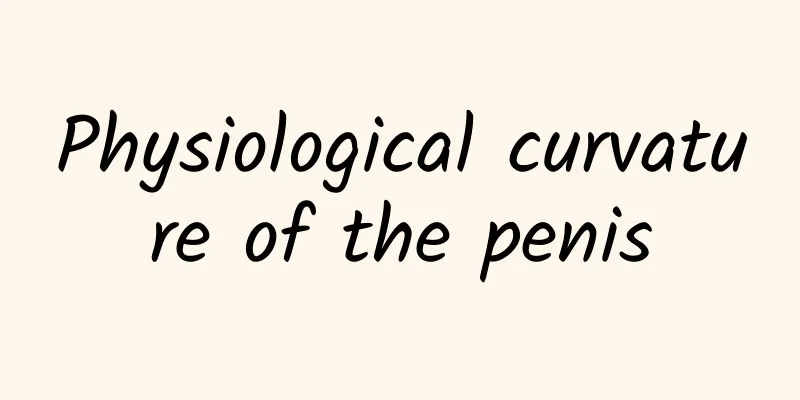Physiological curvature of the penis

|
In daily life, men generally ignore or even neglect the clinical symptoms of "penile curvature", a common phenomenon among men. Some penile curvatures are ignored because they are extremely mild. However, among the patients we interviewed, we learned through communication with the patients that many men are troubled by this. In fact, most of them are physiological curvatures. Among them, congenital penile curvature deformity is often accompanied by hypospadias, but some may occur in the inverted opening of the urethra, which is called simple penile curvature deformity, accounting for about 4-10% of the cases of curvature deformity. The male genitals can bend ventrally (inferior curvature), between the bones (upper curvature) and laterally, among which the more common case is the lower curvature. The earlier view that the key to penile curvature was caused by abnormal growth and development of the urethra has been widely questioned. In recent years, many doctors have found that the difference in the corpus cavernosum of the penis is also one of the key causes of penile curvature. 1. Confirmation Penile curvature can usually be diagnosed by visual examination, but the degree and cause of curvature usually need to be confirmed during surgery. Before surgery, the penis should be observed when erect, and a catheter or urethral bougie should be used to check whether the urethral opening is dysplastic, as well as the relationship between the ventral genital skin and the urethral opening. Before seeing a doctor, the patient can take photos of the shape of the penis erection on his own, usually from the interosseous, ventral and two sides to understand the position of the penis curvature. In order to effectively treat the penis curvature deformity, the treatment should be selected based on analysis. 1.1 At present, simple penile curvature is divided into four types according to the cause of the curvature: 1) Skin flexion. If the male genitals are straightened after being removed from the condom and separated, it is a skin flexion. This type of flexion is the mildest and the actual correction effect is satisfactory. For example, if the foreskin is too long and the frenulum is too short, the glans penis will be stretched and cause the penis to bend downward. 2) Myofascial flexion. If the flexion is still there after the penis is removed and the penis is erected, and there is high-density fibrous tissue around the urethral opening, and the male genitals become straight after removal, then it is myofascial flexion, which is caused by abnormal growth and development of Buck muscle fascia and fascia, and fibrous muscle atrophy. This type of treatment requires sufficient removal of fibrous tissue around the urethral opening. 3) Asymmetric curvature of the corpus cavernosum of the penis. The length of the corpus cavernosum of the urethra and the urethral opening is normal, but the length of the corpus cavernosum of the penis is different on the dorsal and ventral sides or on both sides, causing curvature. For example: a) Abnormal growth and development of the tunica albuginea of the penis. Because the growth and development of the tunica albuginea of the penis is unbalanced, one side is too tight and the other side is too loose, resulting in ventral curvature, dorsal curvature and lateral curvature of the male genitals. b) Corpus cavernosum lump disease. This disease not only causes dorsal curvature or lateral curvature of the male genitals, but also continues to cause erectile pain and erectile dysfunction. c) Male genital trauma. Excessive sexual intercourse and incorrect sexual postures can lead to genital damage and rupture of the tunica albuginea. Scars will form in the future, leading to penile curvature and unhealthy lifestyle, such as uneven force during masturbation, wearing tight underwear that causes the male genitals to tilt to one side for a long time, etc. 4) Urethral orifice curvature. The corpus cavernosum of the urethra on the ventral side of the male genitalia grows abnormally or lacks it, which is mainly manifested by a short urethral orifice, a chemofibrous urethral orifice, or a thin mucosal urethral orifice, resulting in penile curvature. This type of curvature should be treated by urethral sublysis, and the incompletely developed urethral orifice needs to be removed and reconstructed. If the urethral orifice has a good structure, it can be cut off and the missing part of the urethral orifice can be reconstructed. Among the four types, those caused by urethral hypoplasia account for less than 10% of simple penile curvature cases, but are more common in patients with hypospadias. The first three types account for similar proportions. 1.2 According to the severity of the bend, the angle of the bend of the male genitals when erect is accurately measured: 1) Mild: bend less than 30 degrees; 2) Small to medium: bend between 30-45 degrees; 3) Severe: bend more than 45 degrees. Most doctors believe that bends more than 30 degrees need to be corrected by active surgery. 2. Medical Treatment Most penile curvature is not easy to improve with the growth and development of the patient's body. Instead, due to the influence of estrogen and sexual activity after puberty, symptoms become more obvious, such as painful erection and inability to have sex. At present, the most commonly used surgical treatments for penile curvature are 16-point penile tunica albuginea stretching technology and patch transplantation technology. Simply put, the penile tunica albuginea stretching technique is to reduce the tunica albuginea on the other side of the bend by various methods to correct the bend, which is suitable for patients with longer penises; the patch transplantation technique is to cut the tunica albuginea on the reduced side of the penis and use different materials to repair the damaged area, which is suitable for patients with shorter penises. 1. Indications for surgery: a) The bend exceeds 30 degrees; b) accompanied by significant symptoms, such as painful erection, inability to have sexual intercourse, etc.; c) The patient's mental and psychological state requires it. 2. Surgical treatment procedure flow: During the operation, a manual erection experiment should be performed after the male genital sleeve-like dispersion, which is a key step to further evaluate the clinical type. Depending on the situation, sometimes several manual erections are required to accurately distinguish the type of penile curvature and make corresponding solutions. If the male genital skin sleeve-like dispersion reaches both sides of the male genital scrotum junction area, the erection experiment shows that the curvature has been corrected and it should be regarded as a skin curvature. If there is still a slight residual curvature, the fibrous tissue around the urethral orifice should be completely removed and loosened to observe whether it belongs to the second type. If the curvature deformity is still long-term after manual erection again and it is not related to the length or incomplete development of the urethral orifice, it should be solved according to the growth and development of the corpus cavernosum and tunica albuginea. Corrective surgery for penile curvature may be performed between the male genital bones or on the ventral side. The location and method of correction should be determined based on the boy's developmental status and the severity of the curvature. For more severe curvatures, especially those with short urethral openings, immediate urethral opening reconstruction is often required to achieve success. 3. Common surgical treatment methods: 3.1 Nesbit surgery is widely used in the treatment of corpus cavernosum anomalism (interosseous joints are more ventral). In the early stage, only the interosseous joints at the bending end were stretched and sutured without cutting or removing the tunica albuginea. Due to the occurrence of short-term relapses, the improved surgery required a transverse longitudinal suture of the tunica albuginea at the bending end or a wedge-shaped removal followed by surgical suture. 3.2 TAP retraction and resection of the tunica albuginea is widely used, mainly for infants and adolescents with corpus cavernosum discrepancy. After confirming that the flexure is caused by corpus cavernosum discrepancy, the tunica albuginea is separated at the midline of the interosseous point of the flexure (2 o'clock and 10 o'clock) and raised to the Buck muscle fascia to prevent actual manipulation of the neurovascular bundle. Two parallel transverse incisions (about 8 mm long and 4-6 mm apart) are made on both sides of the tunica albuginea, and the anterior and posterior edges of the four cut edges are surgically sutured (the tunica albuginea strips are buried and knotted). 3.3 16-point penis tunica albuginea stretching method The 16-point penis correction method was developed by Professor Tom Lue, a well-known American expert and scholar. It is also known as the "Bei Bei Jia" operation in the hospital. There are three key reasons for the use of this surgery: (1) Recent anatomical studies on the male genitalia have found that nerves are distributed in a network-like manner on the surface of the tunica albuginea between 1 and 5 o'clock and between 7 and 11 o'clock. The 12 o'clock area, which is the center line between the bones, is a nerve-free area. In addition, the thickness of the tunica albuginea at this point is relatively large, making it suitable for tunica albuginea stretching. (2) Diagnostic experience shows that it is almost impossible to completely avoid damaging the nerves when separating the two sides of the center line and raising them to the Buck muscle fascia. (3) A high proportion of ED cases appear in long-term follow-up cases treated with tunica albuginea stretching surgery outside the center line. Parallel longitudinal sutures are made on both sides of the deep dorsal vein of the male genitalia at the 12 o'clock area between the bones of the corpus cavernosum of the penis. If the curved segment is longer or the male genitalia is thicker and more developed, more sutures can be made to stretch. This operation can correct most non-skin-muscle fascial penile curvature. 3.4 Rotation of the corpus cavernosum is common in cases of extremely severe curvature associated with hypospadias. After the urethral meatus is dispersed, the tunica albuginea of the corpus cavernosum is incised longitudinally along the ventral center line, and surgical sutures are made on both sides of the corpus cavernosum under the interosseous Buck muscle fascia (under the neurovascular bundle), and the corpus cavernosum is rotated dorsally to correct the curvature. 3.5 Corpus cavernosum and urethral corpus cavernosum separation is also known as anterior urethral release and urethral meatus enhancement. In the treatment of epispadias, the method of male genital separation has been used more frequently in recent years. Some doctors also use this method for very severe cases of hypospadias accompanied by urethral hypospadias. According to reports, after thorough separation of the corpus cavernosum under meticulous operation, the corpus cavernosum of the penis in about 2/3 of the cases was fully straightened, and the curvature of the other 1/3 was significantly relieved (only a simple curvature correction operation was required). This operation has a wide range of surgical treatments, is prone to damage the nerves and blood vessels of the male genitals, has high requirements for the beauty seekers, and is difficult to promote. 3.6 Penile Corpus Cavernosa Patch The tunica albuginea stretching surgery is accompanied by a certain degree of penile shortening. Therefore, for cases of extremely severe penile curvature and short male genitals, many doctors believe that penile corpus cavernosum patch should be performed to preserve sufficient male penis length. This procedure is mainly used for extremely severe penile curvature cases (often accompanied by hypospadias). Common transplant patches include white tunica albuginea patch (taking the convex side white tunica and transplanting it to the concave side), dermal patch, sheath tunica albuginea patch, venous patch, dura mater patch, artificial material patch, etc. In recent years, due to the development trend of tissue engineering, commercialized white tunica patch has entered the domestic market and achieved relatively satisfactory results. 3.7 Other surgeries |
<<: I regret having laser treatment for pearl rash
>>: Penile curvature correction surgery experience
Recommend
What should I do if my scrotum itches?
If the scrotum has a burning sensation, men must ...
How can a man become handsome?
Regardless of gender, age or status, everyone lik...
What causes genital redness, swelling and itching?
It is said that women's reproductive organs a...
Why does male urethra sting when urinating?
Many male friends experience stinging pain when u...
What can replenish the testicles?
Men often suffer from physical exhaustion and sex...
What are the normal manifestations of male sexual function?
Whether sexual function is normal or not is an is...
Do men have leucorrhea?
Leucorrhea is secreted from the female vagina and...
What to do if your clitoris itches
In fact, men pay less attention to hygiene than w...
What methods can be used to treat enlarged pores? Three must-have methods for men to shrink pores
Large pores are a typical skin problem that many ...
What are the symptoms of male genital herpes?
If a male friend develops genital herpes, he or s...
How to treat a broken nose and when to choose the best time to treat it
Nose fractures are common in real life. Generally...
What is the method for permanent facial hair removal for men?
Shaving can be said to be a daily compulsory cour...
What should I do if hyperthyroidism relapses? This adjustment can avoid
The most special thing about hyperthyroidism is t...
When will a 16-year-old boy recover from his rebellious period?
Children grow up in different stages, and their p...
What are the early symptoms of male genital herpes?
I believe everyone knows that genital herpes is a...









